Crapshoot: The FMV spy game featuring actual former heads of the CIA and the KGB
We're rerunning Richard Cobbett's classic Crapshoot column, in which he rolled the dice and took a chance on obscure games—both good and bad.
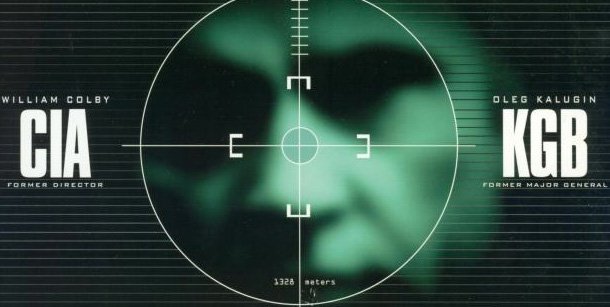
From 2010 to 2014 Richard Cobbett wrote Crapshoot, a column about rolling the dice to bring random obscure games back into the light. This week, he'd tell you about this classic interactive movie, but... one second. Oh. Turns out it's not actually classified and never has been. Never mind.
In a way, Spycraft marked the end of the Cold War. Many publishers have brought in celebrities to lend their voices to games. Somehow, in the height of the interactive movie boom, Activision managed to get both former CIA director William Colby and his KGB opposite number, Oleg Kalugin in front of a camera. How? Possibly they were impressed by the veracity and care that went into creating this, the most realistic spy adventure ever. More likely, money. Lots and lots of money. But who cares? Welcome to the only game where you get to be a CIA agent, and work alongside an actual head of the CIA.
Despite its name, I wouldn't say Spycraft was The Great Game. A Good Game, definitely, though I appreciate that wouldn't have looked as good on the box. It's easily one of the most ambitious interactive movies of the mid-90s, not simply for its high-profile cast members, but for its use of proper sets instead of just endless chromakey effects, an attempt to tell a proper spy story, and a lot of story—at least by interactive movie standards. It came on three discs, and used both them, and the format, extremely well—not least by finding ways to hide the limitations and even make them work for it.
You play a CIA field officer called Thorn. Just Thorn. In a classic gaming "Aaargh!" moment, you never see Thorn's face or even ungloved hands, and are never referred to as male or female, with characters bending over backwards to avoid using any gender-specific language. Unless you screw up, in which case you get unceremoniously sent to a men's prison.
Still, it's the thought that counts, eh? At this point in gaming, even acknowledging the player wasn't definitely going to be a guy was pretty progressive stuff, to say nothing of making a whole spy game with no sexy secret agents to seduce, or ridiculous James Bond gadgets to play with. At one point, a sonic attack and a prototype gun are thrown into the mix. But that's about all. Unlike most spy games, Spycraft plays things straight; if admittedly still as far away from Tinker Tailor Soldier Spy as Casino Royale and the '60s Casino Royale that nobody ever talks about any more. For many good reasons.

Here's a pretty simple example of how Spycraft worked. As the game starts, a newspaper informs you the President is about to sign a treaty in Moscow, and you're summoned to CIA HQ (via what will turn out to be a magic PDA) to join a team. There, you meet up with a handful of vaguely "Hey, isn't that..." level TV actors, including Leeta from Deep Space Nine (best known for providing fanservice and ultimately marrying a small orange troll), for lots of talk about how serious the mission is and how critical things are, but not, notably, what the mission is. Instead, you're told that you're the best of the best of the best, and in pretty much the same breath ordered to go to a training camp to prove that you're capable of the core espionage techniques of 'basic reading' and 'clicking on stuff'.
Maybe there wouldn't be so many moles if the boss had more respect, huh?
The biggest gaming news, reviews and hardware deals
Keep up to date with the most important stories and the best deals, as picked by the PC Gamer team.
Even here, there are some nice touches. A voicemail you can optionally listen to hints at trouble down on The Farm, where you've been sent. A TV report casually drops in a mention of a Russian presidential candidate having been assassinated and some of the political turmoil going on in the world. And of course, there's what your training ultimately ends up involving—the Image Analysis tool.
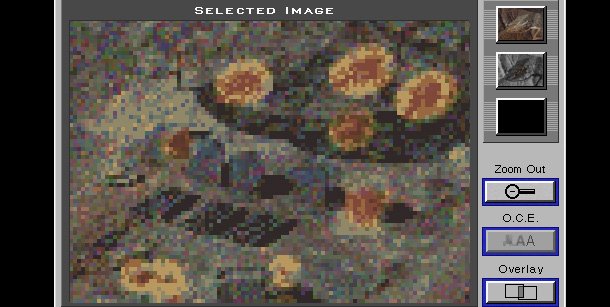
Spycraft's charm is that while none of its tools are exactly complex programming in action, and in many cases are about as realistic as the special effects in Birdemic, they're great at conveying the feel of being an actual spy using actual spy tools. In most cases, they appear exactly once, so their limitations never have too much time to become obvious, and aren't too futuristic. Even when they are, it's only by mid-90s standard: Thorn's PDA for instance and its ability to hook into this magic thing called 'the internet' to pull extra data from specially created websites that are long since dead.
Image Analysis for instance is, as a pure 'game', dirt simple. You have to get the license plate of a car, which consists of clicking on a said car and then a button marked 'OCE' to enhance it and make it readable. You then click 'Report', choose the right option from a list of three, and are told "Holy cow! You smoked that one!" as if you'd actually done something impressive.
Except...
The wrapping sells all this as something more; a quick line explaining that the photo is of a drugs cartel at work, and that you're tracking down a rogue. Stage 2 of training then continues by using the same basic technique to count the number of tanks in a photo using infrared data and... uh... basic numeracy. This is then followed by a light-gun shooter as you work your way through a paintball exercise to prove you have what it takes, which ends abruptly when your trainer is shot through the face by a sniper mid-way through telling you you suck. It may be a simple game mechanically, but Spycraft knows how to keep things moving, and keep you on your toes.
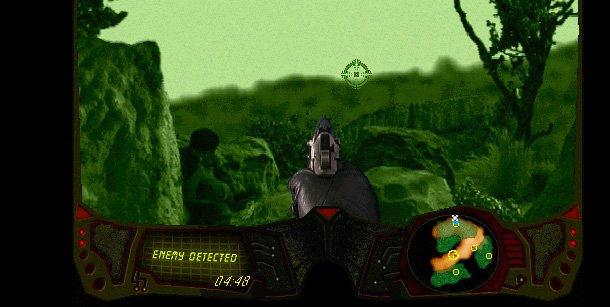
Much of the plot is fairly generic, and not worth going through in detail. The minigames though are highly enjoyable, especially if you can get sucked into the atmosphere. Here for instance is how you track down a sniper at a political rally using the magic of science and convenient applications...
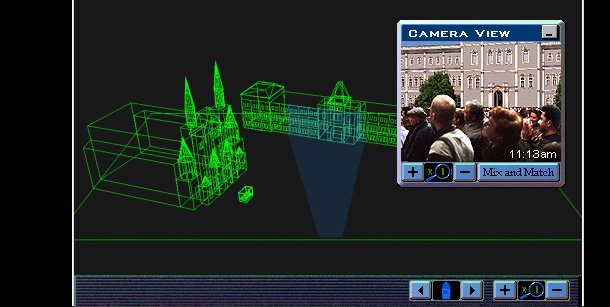
This tool, which again you use exactly once, is called KAT (Kennedy Assassination Tools, in an amusingly morbid detail), and starts by building a model of Red Square for you to play with and not ask where the photos came from. You pan and spin around it, connecting the bullet's impact points together with a line and tracking it back to find the shooter in a window. Having found him, you hop into another tool where you create a photofit of the guy's image to track down his identity and...
...hang on a damn minute, is that Niles Crane?
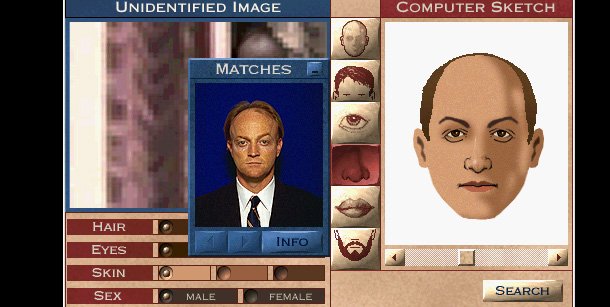
And from there, jump into a weapons database to figure out exactly how he managed to make the shot without the bullet being recovered, which points you to a new experimental gun called the PEG. With that done, you move to the next part of the investigation and so on and so forth until the world is saved from terrorists/communists/our reptilian overlords.
It's very linear, and you pretty much never get to touch anything if it's not directly related to your next job (with the exception of a Mahjongg game on Thorn's computer). Still, interactive movie. With some of these, you were lucky to get to click stuff.
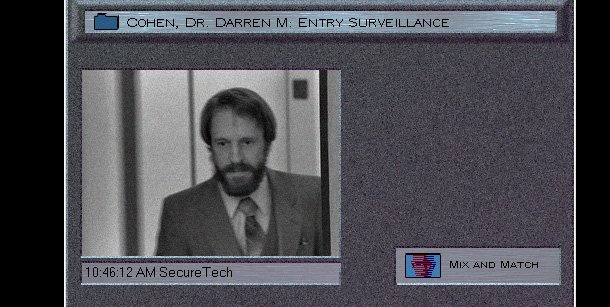
What follows is easily the most memorable part of the game—the hunt for Niles Crane and his associates, and how they got their hands on an experimental weapon. It begins by logging into the PEG laboratories security system and browsing for suspicious activity. Four people have access, and anything odd is flagged. You can play their phonecalls, see irregular elevator use, check attempts to access the PEG, and even see surveillance photos of any times they entered the building out of hours.
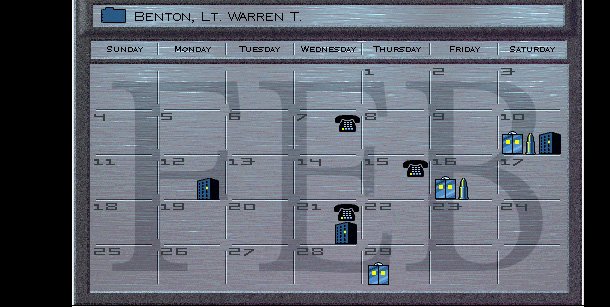
With these tools, you slowly sift through the details and discover that while top secret labs might well be sealed and rocket-proof and have all manner of other protection, they're useless compared to the most dangerous weapon of all: a bad false beard from the local costume shop.
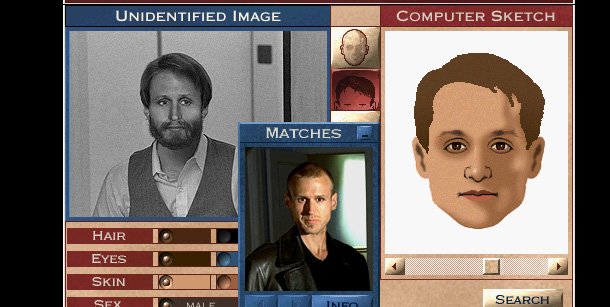
This new guy turns out to be "Grendel", a retired FBI agent turned corporate spy. He didn't do the job alone, however, as more listening in on phonecalls soon reveals. Their patsy, a scientist called Cohen, was honey-trapped by his partner, a former North Korean agent called Ying Chungwang. A picture emerges. She suckered him away from his wife/desk so that Grendel could do the deed, Grendel stole the PEG and handed it to Niles, who made the hit on the behalf of whoever the hell is pulling the strings.
As simple as the puzzle is, it's really fun to pick all this stuff apart and figure out what happened. However, it's nothing compared to what's coming up—which would seem to be a good point to show this, which pops up mid-way through the installation program, long before Modern Warfare 2 did it...
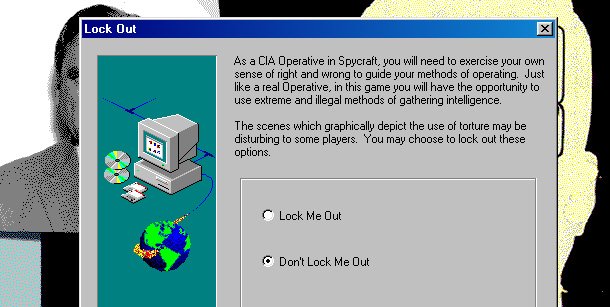
Before worrying about that though, Thorn gets a mysterious message telling... uh... himur... to report to a seemingly innocuous house in Halifax. Apologising for the cheap theatrics, you're introduced to Bill Colby personally. How to put this politely? He's not much of an actor. "I've heard a lot about you, Thorn." he states, reading the script. "Impressive, so far," he continues, because that is what the script says.
(I'd love to know what he thought of the actual game. Unfortunately, he passed away in 1996, not long after this game came out, so we're never likely to find out. Kalugin on the other hand is still around, and even advising a spy museum. Wonder if a copy of this game is anywhere in there...)

This is the inevitable bit of any spy story where everyone acknowledges that there's a mole in the Agency, though with the twist that Colby does actually show up at a few points later on, and he plays an active role as the person you're expected to report any suspicions to. Kalugin by contrast only puts in a cameo, but getting a cameo from a former Major General of the KGB in a silly spy game is still quite a coup. And he probably orchestrated more than a few of those in his time.
Colby's presence becomes all the more surprising when Ying is captured in Moscow, thanks to a little code cracking and other cleverness on your very-nudged-to-the-right-place behalf. Hurrah! However, as you'd expect, she's not interested in talking. To break her, you have two choices: one legal, one... very, very much not, especially in an era before Jack Bauer made it cool to break the rules.
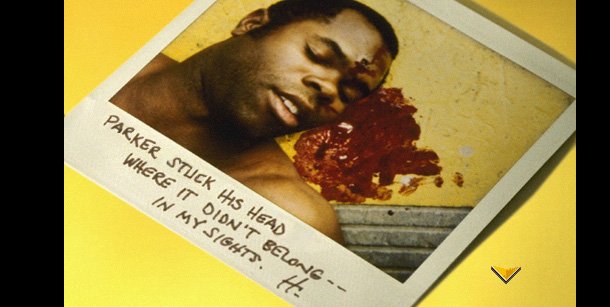
The legal way is to convince her that you've already got Grendel in custody, and use her feelings for him to make her spill the beans. This involves using Fake Photoshop to manufacture a convincing bit of evidence, starting with a picture of some random schlub in custody and dragging in the appropriate props.
It's a fun, if finnicky, puzzle where you have to pick not only the right props, but factor in angle, size, and light sources. Various inventory objects will tell you, for instance, what brand of cigarette Grendel smokes, while your own team will tell you if you should leave fakery to the pros.
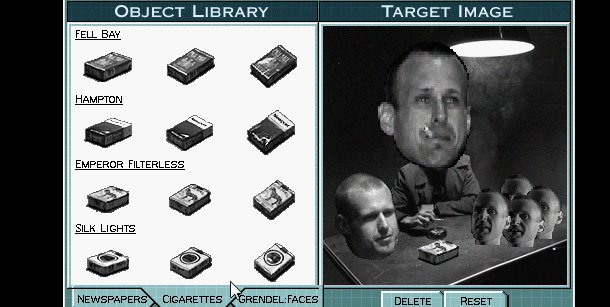
Can't do it? There's always Option B...
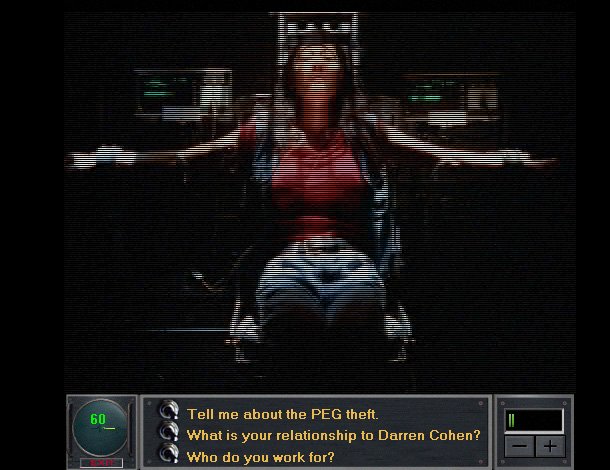
This is the Bullpen, and while it might be referred to as 'enhanced interrogation' these days, Spycraft is from a time when strapping someone into a chair and sending painful electric shocks through them was correctly referred to as 'torture' and agreed by all to be 'a very bad thing'. Spycraft still lets you do it though, in what's a fairly tame sequence by Hollywood standards, but pretty rough for mini-games.
The way it works is that you ask Ying questions, each kicked off by a jolt of electricity. The higher the intensity, the more pain you cause, but the greater risk that she'll die—and if she dies in the chair, you're off to jail. Early on, responses are a mix of defiant laughter and heavy breathing; as you ramp it up, it becomes screams and cries of "It burns!" and "Let me go! For god's sake, let me go!"
At least, that's the theory. In practice, if you ramp up the pain to full at the start, you just win. It's if you go all namby-pamby-liberal that she collapses and you get a one-way trip to the big house.
It's a fairly strange message, really. "Torture! It's OK when it works!" And that's as far as Spycraft takes it. Nobody even mentions this bit again as long as you get the information you need, including the Moscow Station Chief who makes at least a slight moral objection to it when you demand the Bullpen be pulled into service without even trying the alternative or even having a friendly chat. Even your boss at the CIA, who specifically orders you not to do the torture because he's totally the villain of the game he's a dedicated, by-the-book Company man, doesn't so much as offer a peep of disdain afterwards.

Anyway...yeah. It's unpleasant stuff, even if it is unfortunately easy enough to convey the idea that torture is a viable way of getting information, as opposed to widely condemned for being pretty useless in real world situations even before you consider questions of morality.
Still, it does add a whole new dimension to pixel-hunting. Do you have what it takes to stick it out, or do you reach straight for the electric chair? Spycraft may tell you something about yourself you didn't want to know... or simply remind you that this is a game and it therefore doesn't matter even a little.
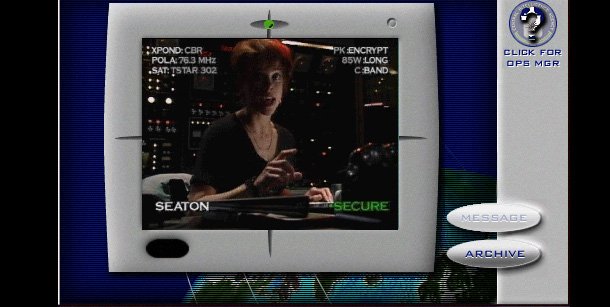
The rest of Spycraft follows a similar pattern to these sequences, with funky-themed minigame after minigame as you discover the conspiracy, and are incredibly surprised when the mole turns out to be exactly who you assumed it was to begin with. There's some shooting and some more data work, and in the end it turns out the whole thing was the dream of a turtle. Or a conspiracy. One of the two.
Here's a handy Let's Play covering the entire game. See if you can guess in advance whether he takes the 'photograph' or 'torture' route to saving the day, and who the mole is. Sadly, it's not Colby. Though wouldn't that have been an awesome twist if he'd been prepared to let them do it?

